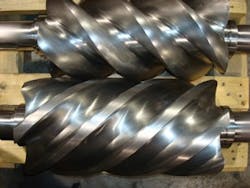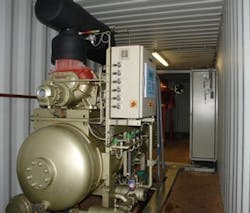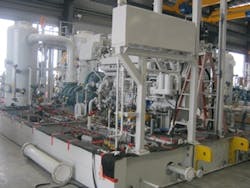GAS-ENGINE-DRIVEN COMPRESSOR
Figure 3. Large screw compressor is mounted on package skid (heavy-duty baseplate) near the suction drum and the oil separator vessel (vertical vessels).
Advantages. Potential benefits of a wet screw compressor compared to a centrifugal machine include: • considerably reduced sensitivity to gas molecular weight changes; • higher efficiency;• for medium sizes (up to 4 MW), lower cost and better performance;• high ratio pressure capability; and• direct connection to the electric motor driver, eliminating speed-increasing gear units.Compared to a reciprocating machine, a wet screw compressor boasts: • capability to accept more liquid and entrainment;• considerably less maintenance;• higher reliability and availability; • smaller size (for a compact design);• lower cost; and• the possibility of doing without a spare machine. Wet screw compressors commonly are used in range of 100 kW to 3.5 MW. Capacities typically range from around 400 m
3/h to approximately 18,000 m
3/h. The compressors usually are applied for discharge pressures up to around 50 barg (for vertically split casing designs). Some very large screw compressors (usually with horizontally split casings) are available for capacities as high as around 50,000 m
3/h — but they have limited pressure capabilities (say, below 17 barg).Operational flexibility is another advantage. Starting-up a wet screw compressor with nitrogen and then gradually bringing in the process gas mixture doesn't change the performance (if the selected oil is suitable for all the compressed gases). This is a great advantage compared to dynamic compressors such as centrifugal ones.
Disadvantages. Although horizontally split casing screw compressors can provide high capacity, they only are made by a few companies and rarely are used. So, realistically, the maximum capacity of a wet screw compressor is 10,000–20,000 m
3/h, depending upon the application. (Above these limits, use a centrifugal machine.) The biggest frame that many screw compressor manufacturers can offer is limited to 2.5–4.5 MW, depending upon the service. In other words, a wet screw compressor only can cover small and medium ranges. There also are some pressure capability limits, say, 25–55 bar, depending upon the application.Oil carryover is the biggest problem. It has afflicted a wide variety of services. If an application requires a dry gas, don't consider a wet screw compressor. It also might not make sense for handling complex process gases that may change composition over time — unless at least two successful references exist for the application. For example, process gases containing a considerable amount of relatively heavy hydrocarbons that can dissolve into the oil can cause breakage of the oil film at the bearings and could lead to wear and other problems. Advanced synthetic oils can lessen this issue but are expensive. (A reciprocating compressor probably is the best option.) Flare gas recovery applications also pose challenges in selecting an oil that can operate successfully in the wide range of gas compositions encountered. (A liquid ring compressor is a better choice.) Gases containing corrosive or sour traces, particularly gases that can contaminate the oil, can create problems for the compressors.Many processors still prefer low-speed, long-stroke reciprocating compressors to wet screw compressors for various small- and medium-size applications — feeling the proven track record of reciprocating machines outweighs the first cost advantage of wet screw compressors. The reality is that reciprocating compressor technology is more mature than that of wet screw compressors. There's lots of accumulated knowledge and experience in the design, fabrication, operation and troubleshooting of reciprocating machines. (Reciprocating compressors are the best choice for some specific applications — such as ones involving small flows, light gases and high-pressures.)Always consider the capacity, the pressure and the service (particularly successful references for it) in compressor selection. Carefully evaluate all plant-specific requirements and all aspects of offered compressors.
PERFORMANCEBecause of their high availability and reliability, screw compressors built by reputable manufacturers (particularly machines manufactured according to API 619) are popular for single stream installation, i.e., without a spare. However, straying far in operating pressure or — in particular — temperature from design conditions can lead to deformations that generally exceed the specified manufacturing tolerances. In other words, off-design operations could result in screw rotor rubbing, permanent material loss and efficiency reduction. To more realistically evaluate the behavior of a wet screw compressor package, the shop performance test should use the application's gas and oil. If using these isn't feasible, perform the test with a gas (usually a mixture of inert gases) of molecular weight and isentropic index value (known as the "
k") equivalent to the job gas across the specified operating envelope, and carefully note the characteristics of the oil. Critical issues with the performance test are: • the guaranteed power (usually a 3–4% allowance is acceptable); and• covering the full operating envelope, particularly the low and high suction pressures. The oil flush prior to start-up is critical. A wet screw compressor is sensitive to particulates in the oil. Monitoring of oil pump discharge pressure is important; it should be set to around 3 bar above the compressor gas discharge pressure.
AMIN ALMASI is a rotating equipment consultant based in Brisbane, Australia. E-mail him at [email protected].






